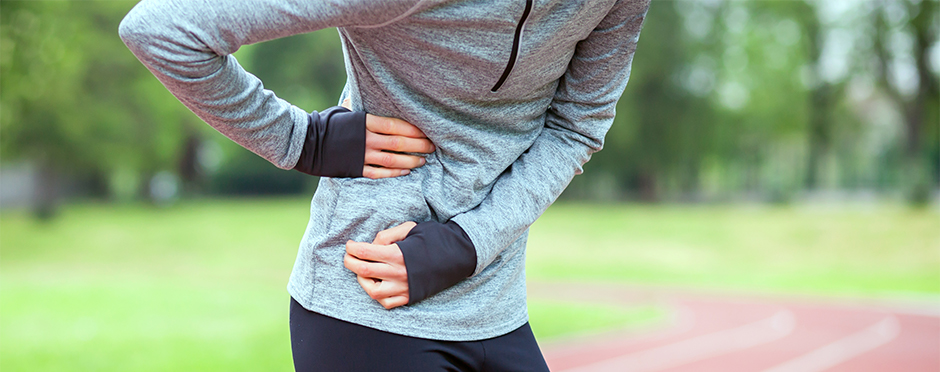
The Dreaded Side Stitch
2 Comments“When things look worst, we run the most.” This is a quote from Christopher McDougall in the famous book Born to Run and how, in times of great stress, we run. McDougall mentions three times in this country’s history that there have been substantial running booms: the Great Depression, Vietnam, and September 11th1. “Maybe it was a coincidence. Or maybe there’s a trigger in the human psyche, a coded response that activates our first and greatest survival skill when we sense the raptors approaching.” – Born to Run.
It is reasonable to think that we are currently in the midst of this country’s fourth running boom due to the uncertainty surrounding the Coronavirus. So, now is the perfect opportunity to speak on one of the more common symptoms with running: the dreaded side stitch.
Exercise-related transient abdominal pain, or “side stitch” pain, affects nearly 70% of runners in a given year. The pain is typically described as sharp or stabbing in severe cases and cramping, aching, or pulling when less intense.2 Localized pain is described in around 80% of those experiencing a side stitch.2,3 Interestingly, age seems to be protective with the side stitch: 77% of active individuals under the age of 20 years experienced the pain versus only 40% of individuals aged 40 and older in a study by Morton and Callister.4
The side stitch can be detrimental to performance and may compromise sports participation2,3 Few things can halt the endorphins flowing through your body faster than a sharp, localized pain along the border of your rib cage. So, just what causes this to occur?
Potential Causes
There is no conclusive cause of exercise-related abdominal pain to date but, there are commonalities among different activities that produce this phenomenon.5 Side stitch pain is most prevalent in activities that involve repetitive rotation of the torso, especially when the torso is also in an extended position.2,6 Running and swimming, although very different activities, place the body into this movement pattern and have a high rate of side stitch pain. Another theory proposed could be the increased friction between two layers of the abdominal cavity being a potential cause of this pain.2 A recent study found that individuals with a history of side stitch pain had lesser core stability than those without side stitch pain.
Management
When it comes to the side stitch, prevention is much more effective than are strategies to implement while this pain is occurring. But, there are movements that may be worth a try if this pain occurs such as deep breathing or pushing on the affected area.2
Unfortunately, the current and most effective strategy for relieving this pain is to stop exercising.8-13 Below are a few ways that you can reduce side stitch pain from occurring.5
- Avoid large volumes of food and beverages from at least two hours prior to exercise
- Improve posture, especially in the thoracic region (mid back)
- Improve core strength in order to further support abdominal organs
Previously discussed in a blog, your tissues are capable of changing. It is recommended to improve upon the mobility and strength in your torso, allowing for a more efficient running gait. Here are some exercises to do just that:
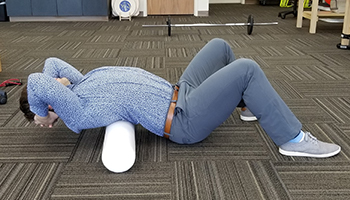
Thoracic extension mobilizations over a foam roller
This exercise is to be performed over your thoracic spine or the portion of your back in which ribs attach. Keeping your bottom on the floor and supporting your head, extend your trunk over the foam roller until you feel a stretch. Be sure to perform this over several areas of your middle back and focus on areas of increased tightness.
- Perform 10 reps over several levels of your thoracic spine, moving up and down, 1-3 times/day
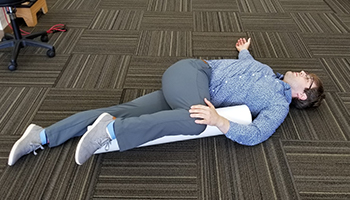
Thoracic rotation stretching with a foam roller (open books)
In side lying with the top leg over the foam roller, attempt to flatten your shoulders on the ground or table without letting your hips move. Hang out in the position in which you feel a stretch for a few seconds, then return to the starting position.
- Perform 10 reps, 1-3 times/day
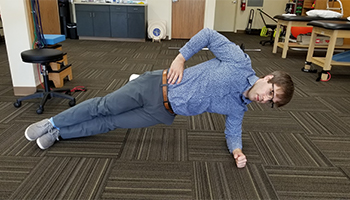
Side plank
Think of your body as a wooden plank, maintaining the position without movement. The most common compensation is your bottom hip moving closer to the ground. Be sure to monitor this throughout the exercise. Set a stopwatch with the goal of increasing your time each day. If you perform to fatigue, you will be stronger.
- Perform 3 sets of 15 seconds or more, once/day
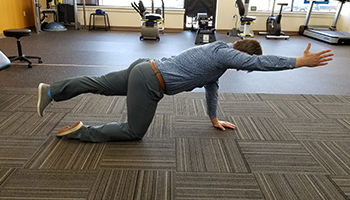
Bird dogs
Strive for no movement of your trunk, creating a stable platform for your arms and legs to move from. Simultaneously move your right arm and left leg to your trunk, then return to position of outstretched arms and legs. Then switch sides.
- Perform 3 sets of 10 on each side, once/day
If you experience side stitch pain on a regular basis, a physical therapist can assist in resolving postural, strength, or running mechanics deficits that may be contributing to this discomfort and set you on the path to pain-free running. Click here for a free assessment. Free assessments are available both in-clinic and virtually through our telehealth platform.
The Athletico blog is an educational resource written by Athletico employees. Athletico bloggers are licensed professionals who abide by the code of ethics outlined by their respective professional associations. The content published in blog posts represents the opinion of the individual author based on their expertise and experience. The content provided in this blog is for informational purposes only, does not constitute medical advice and should not be relied on for making personal health decisions.
References:
1. McDougall, C. Born to Run: A Hidden Tribe, Superathletes, and the Greatest Race the World Has Never Seen. Knopf. p. 157.
2. Morton DP, Callister R. Characteristic and etiology of exercise-related transient abdominal pain. Med Sci Sports Exerc. 2000;32(2):432-38.
3. Morton DP, Richards D, Callister R. Epidemiology of exercise-related transient abdominal pain at the Sydney City to Surf community run. J Sci Med Sport. 2005;8(2):152-62.
4. Morton DP, Callister R. Factors influencing exercise-related transient abdominal pain. Med Sci Sports Exerc. 2002;34(5):745-59.
5. Morton D, Callister R. Exercise-related transient abdominal pain (ETAP). Sports Med. 2015;45:23-35.
6. Morton DP. Exercise related transient abdominal pain. Br J Sports Med. 2003;37(4):287-88.
7. Mole JL, Bird ML, Fell JW. The effect of transversus abdominis activation on exercise-related transient abdominal pain. J Sci Med Sport. 2013;17(3):261-65.
8. Kugelmass IN. The respiratory basis of periodic subcostal pain in children. Am J Med Sci. 1937;194:376-81.
9. Stitch ETC. Guy’s Hospital Gazette. 1932;46:165-66.
10. Morton DP, Callister R. Spirometry measurements during an episode of exercise-related transient abdominal pain. Int J Sports Phsyiol Perform. 2006;1(4):336-46.
11. Anonymous. Cause and treatment of ‘stitch’. Br Med J. 1945:207.
12. Eichner ER. Stitch in the side: causes, workup, and solutions. Curr Sport Med Rep. 2006;5(6):289-92.
13. Cooper D, Fair J. Preventing chest and upper abdominal pain associated with exercise. Physician Sportsmed. 1977;5(7);93-94.

2 Comments
Colin Crawford
Great article! Informative and well-written.
Jeff
Thanks Jeff Hubka. Very helpful. I’ll be starting on those core strengthening exercises right away!